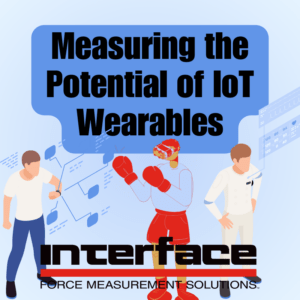Measuring the Potential of IoT Wearables Using Load Cell Technology
 IoT wearables utilizing load cell technologies are smart devices worn on the body that leverage sensors capable of measuring force, weight, or torque. Integrating these sensors with internet connectivity offers a unique blend of real-time data collection and remote accessibility, opening doors for diverse applications.
IoT wearables utilizing load cell technologies are smart devices worn on the body that leverage sensors capable of measuring force, weight, or torque. Integrating these sensors with internet connectivity offers a unique blend of real-time data collection and remote accessibility, opening doors for diverse applications.
Interface has been involved in the IoT market from its early stages, as detailed in Interface Sensor Technologies Enables IoT Capabilities. Empowering inventors and innovators to utilize accurate measurements for connected products. Seamless integration with other IoT devices and platforms is essential for data analysis and broader application, one of the advantages of Interace’s line of wireless measurement solutions.
We make sensors specifically for IoT Solutions in healthcare and consumer products. With the growing requirements for connectivity, Interface load cells provide valuable data in real-time to product engineers and users of IoT wearables.
Internet of Things (IoT) connected wearables have permeated our society across various industries, from sports and medical to fitness and fashion. The technology surrounding wearables has also become more complex in using sensors to provide better and more complete data. Among the sensor technologies used in both the testing and built into the product, force sensors play a large role.
Whether customers use Interface measurement products for prototype testing, usability studies, manufacturing equipment, or small-scale testing machines, we have solutions that improve the use and viability of IoT wearables.
IoT Wearable Applications Using Interface Products
- Gaming hand-held devices
- Wearable simulation garments and headgear
- Gear used in professional sports, including helmets and pads
- Haptic feedback devices
- Smart shoe gait analysis
- Exoskeleton design and prototyping
- Sports equipment feedback
- Smartwatch manufacturing
- VR headset manufacturing
- Treadmill force testing
- Prosthetics development and performance monitoring
Load cells are becoming increasingly popular in designing, prototyping, testing, and using wearable IoT products. They offer a highly accurate and reliable way to measure force, pressure, and weight. Our measurement devices are being designed into wearables such as smart clothing and augmented reality equipment, including headsets and fitness equipment for precision measurement during use.
Use Cases for Load Cells in IoT Wearables
Fitness and Training: These wearables track metrics like muscle activation, balance, and gait analysis, helping athletes optimize their performance and prevent injuries. Examples include smart insoles monitoring foot pressure or resistance bands measuring workout intensity.
Rehabilitation and Physical Therapy: These devices monitor patient progress during therapy by measuring the force exerted on limbs or joints, enabling personalized treatment plans and objective data collection.
Smart Clothing and Shoes: Clothing embedded with load cells can track posture, gait, and activity levels, while smart shoes monitor pressure distribution for customized footwear.
Occupational Safety: In industries like construction or manufacturing, wearables measure pressure on specific body parts to ensure proper posture and prevent musculoskeletal disorders.
The key features necessary to building force sensors for the IoT wearable market are accuracy, reliability, versatility, and sensor size. Load cells must be highly accurate and measure force to a high degree of precision. Force sensors using strain gage technology are well-suited for wearable devices, as they are durable and can withstand repeated use. Load cells are available in various sizes and capacities, with customizable options to embed them into wearables. Manufacturers are building small, lightweight, wearable IoT products, so force sensors must be suitable to take on small and precise forces.
IoT wearables incorporating load cell technology hold immense potential for various domains, from enhancing athletic performance and healthcare monitoring to revolutionizing human-computer interaction. As this technology evolves, we can expect even more innovative applications to emerge that contribute to daily health, well-being, and productivity.
Learn more about Interface’s IoT Solutions.
ADDITIONAL RESOURCES
Wonderful World of Wireless Webinar
Wireless Telemetry Systems 101
IoT Golf Club Swing Accuracy App Note








